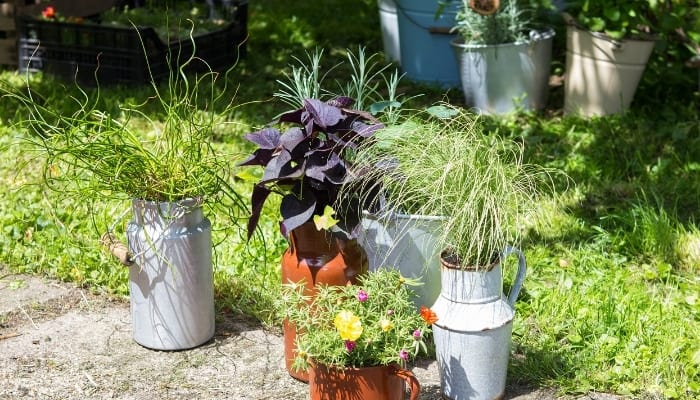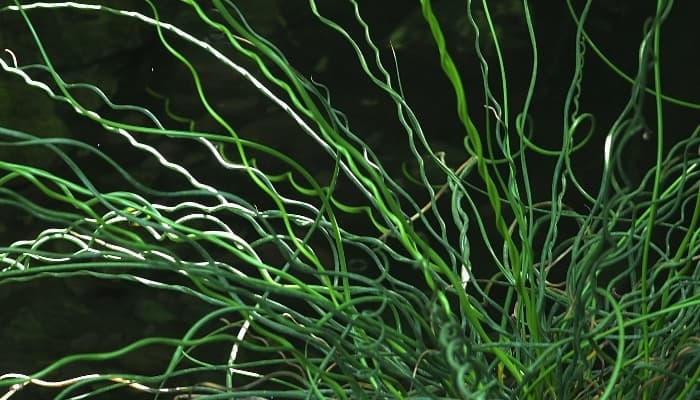An enchanting enhancement to any garden or water feature, the corkscrew rush plant exhibits a profusion of lively spirals.
Below, we’ve put together a short guide outlining all you need to know about this delightful plant, including its preferences, care, and propagation.
Read through to understand its history better, when, where, and how you should plant your corkscrew rush, and when you need to trim it.
Get ready for a mass of dark green curls filling your yard!
What is Corkscrew Rush?
Juncus Effusus Spiralis, also known as corkscrew rush, is a herbaceous perennial and part of the Juncaceae family.
It will come back year after year, but you should prune away the brown bits when they appear or in the early spring.
In hotter regions, corkscrew rush behaves like a semi-evergreen and is an invasive species because of its ability to spread quickly.
In these warmer climates, corkscrew rush can grow stems underground and sprout up new growth. These spreading stems are rhizomes.
Corkscrew rush is not a succulent but is native to North America, among other continents. The spiralis version originally grew in Japan, but it adapts well to North American climates.
Corkscrew rush can grow up to 2 to 4 feet in height and spread about as wide. On the wild versions of Juncus effusus, you won’t find the fun characteristic curling stems of the spiralis type.
However, you will still see the small groupings of yellow and green flowers adorning the dark green stems of the plant.
Caring for a Corkscrew Rush Plant Properly
Corkscrew plants will grow quickly with proper care, which is why they’re often considered a great starter plant for new gardeners.
Below we’ve outlined the ideal conditions your corkscrew rush needs to be healthy.
Where it Grows Well
Corkscrew rush loves water. It grows best along the edges of bogs or marshes but can still flourish in well-drained soil if watered properly and regularly.
Indoor/Outdoor Growing
Corkscrew rush also loves the sun, but as long as you’ve got a good window, it can grow inside or out.
Given its fun shape and structure, many love to add the plant to their interior collection for a little pizazz or keep it outside to expand a garden.
The ASPCA doesn’t list corkscrew rush as toxic to pets either.
While you should always check with your vet, this plant is probably safe to have inside with Fido or Fluffy, even if they chew on it occasionally.
Soil Needs
Corkscrew rush isn’t picky about soil. Any mix will do, even soil that’s acidic or filled with sand, loam, or clay.
In some places, it can help retain soil because of its ability to spread rhizomes through the ground that keep dirt in place.
You may want to consider adding peat or a similar substance to your soil to help it retain water and keep your corkscrew boggy.
However, that’s just for your watering and care ease; the corkscrew rush will grow in almost anything.
Watering Needs
The most important aspect of caring for a corkscrew rush is watering it.
You cannot overwater it, but you can dry it out. They enjoy growing in a few inches of standing water, so if you’re planting them outside around a water feature, you can put them in a pot and partially submerge them.
If you have them inside or not near water, make sure the soil is always wet, even soggy if possible.
Don’t be afraid to shower this plant; it will help its growth and vitality.
Temperature Needs
Given how hearty this plant is, it will only not grow in hot regions without water, essentially deserts.
However, corkscrew rush grows best in full sun. In warmer southern regions, it will also grow well in partial shade.
Their love of the sun can make keeping them well watered difficult, but it’s important to ensure that their soil is always wet.
If you can keep a corkscrew rush in lots of sunshine and well-watered, you will see it shoot up.
Ideal Climate
Their ideal planting zones are 4 to 9. Some reports note that they’re only cold-hardy enough for up to zone six, but information varies.
You may see your corkscrew rush die back in the fall and winter if you’re in a colder climate. But you should be able to revive it in the spring with pruning and a little tender loving care.
Choosing the Right Pot
Because of their eagerness to spread and grow, you’ll likely need to re-pot them every year or two to a pot at least one size up.
If you’re using a pot to plant your corkscrew rush outdoors, you can keep them alone or mix them up with other hydrophilic plants that will enjoy the same watering schedule.
Just be sure to pick plants that want to be as soggy as the corkscrew; otherwise, you could overwater some trying to make the corkscrew happy.
Want to plant a corkscrew rush outside but worried about it spreading everywhere?
Dig a large hole in the ground that will fit the depth and breadth of the pot, and then bury it with just the lip visible over the dirt line.
The pot walls will help prevent the stems from spreading and taking over your garden or lawn.

Propagating Corkscrew Rush
Corkscrew rush will have no problem propagating; the real challenge will be preventing spread.
Transplanting Corkscrew Rush
Given its hardiness and love of water and sun, it’s not too difficult to transplant the corkscrew rush effectively.
Make sure you dig up the roots and rhizomes and then prep the new soil by turning it up and adding a little peat or vermiculite (to help retain water).
Make sure once it’s in the ground or pot that you keep it very well watered and in the sun so it can adapt to its new environment quickly.
How to Propagate Corkscrew Rush Successfully
To propagate corkscrew rush planted in the ground, first prune back the extra stems that may get in your way.
Then dig up the rhizomes (the stem clumps).
Once you have the stem clumps free, use a small saw or knife to cut through them.
When you have as many separate stem plants as you’d like, carefully pull up the roots and replant.
Ideally, you should replant them in loose soil with the roots spread outwards.
You can add peat moss or vermiculite to the dirt to help with water retention.
After you’ve covered the roots with soil and packed it down lightly, water it profusely.
If you’d like, adding a little fertilizer will help kickstart the new growth process and get those curly stems growing.
Use this same method for propagating corkscrew rush into a pot.
How Should You Plant Corkscrew Rush in a Pond?
Corkscrew rush likes boggy edges of ponds or sitting in just a few inches of water.
Unlike lilies or other water plants, corkscrew rush doesn’t want to be fully enveloped in water.
But you can put it in a pot and partially submerge the plant at the fringe of a pond. It can sit there alone or in a pot with other similarly water-loving plants.
Alternatively, you can put them in a submersible container instead of a pot and lay them out in the pond.
As long as they have a little soil and aren’t buried too deep in the water, they will grow well.
Should You Cut Corkscrew Rush Back?
You can cut corkscrew rush back, but the need will depend on your climate.
In warmer zones, it is a partial evergreen, so it may not brown at all and won’t require pruning.
In colder climates, it will brown in the fall and winter. You can cut this growth back in early spring to help encourage new stems to grow.
You can also cut the plant back before transplanting or propagating it for ease of movement. Or, if you’re making a floral arrangement, you can slice a couple of corkscrews off for your vase.
It is a low-maintenance plant, so don’t worry about pruning it unless you see dead stems.
Ready to Plant Vibrant Green Curls?
Corkscrew rush is a great plant for beginner gardeners or anyone looking to add a little pizazz to their green space.
It’s a durable plant that, with lots of sun and water, will grow like the weed it’s considered to be in some areas.
Great for adding to a whimsical bouquet or spicing up a bog edge, plant corkscrew rush to add a visual feature to your garden or home.

